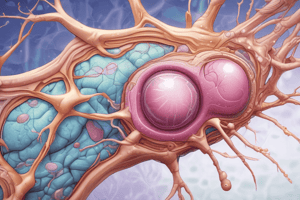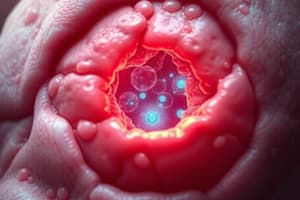Podcast
Questions and Answers
What is a primary role of apocrine glands?
What is a primary role of apocrine glands?
- Lubricate and waterproof the skin
- Excrete waste products through sweat
- Play a role in body odor (correct)
- Regulate body temperature through evaporation
Which location is primarily associated with eccrine glands?
Which location is primarily associated with eccrine glands?
- Underarm area
- Scalp and forehead
- Forehead and palms (correct)
- Genital and perianal areas
What is the main function of sebaceous glands?
What is the main function of sebaceous glands?
- Produce sweat for thermoregulation
- Lubricate hair and skin with sebum (correct)
- Eliminate waste solely through sweat
- Secrete pheromones
Which condition is characterized by overactivity of eccrine glands?
Which condition is characterized by overactivity of eccrine glands?
What type of secretion mechanism is primarily seen in sebaceous glands?
What type of secretion mechanism is primarily seen in sebaceous glands?
What leads to the formation of acne vulgaris?
What leads to the formation of acne vulgaris?
Which secretion mechanism involves the release of a portion of the cell's cytoplasm?
Which secretion mechanism involves the release of a portion of the cell's cytoplasm?
What is a characteristic of eccrine sweat?
What is a characteristic of eccrine sweat?
What is the primary function of eccrine glands?
What is the primary function of eccrine glands?
Sebaceous glands produce a thick milky fluid.
Sebaceous glands produce a thick milky fluid.
Name one condition associated with overactivity of sebaceous glands.
Name one condition associated with overactivity of sebaceous glands.
Match the glandular secretion mechanisms with their descriptions:
Match the glandular secretion mechanisms with their descriptions:
Which of the following is a role of sebaceous glands?
Which of the following is a role of sebaceous glands?
What type of glands are primarily involved in the release of pheromones?
What type of glands are primarily involved in the release of pheromones?
Flashcards are hidden until you start studying
Study Notes
Functions of Apocrine Glands
- Location: Primarily found in the axillary, genital, and perianal areas.
- Secretion: Produce a thicker, milky secretion that contains proteins, fatty acids, and ammonia.
- Function:
- Play a role in body odor as the secretion is broken down by bacteria on the skin.
- Activated during emotional stress, pain, or sexual arousal.
- May have pheromonal functions, influencing social and reproductive behaviors.
Functions of Eccrine Glands
- Location: Distributed widely across the body, particularly on the forehead, palms, and soles of feet.
- Secretion: Produce a clear, watery sweat primarily composed of water, salts (mainly sodium chloride), and urea.
- Function:
- Regulate body temperature through evaporative cooling.
- Help maintain electrolyte balance.
- Assist in excretion of waste products through sweat.
Functions of Sebaceous Glands
- Location: Associated with hair follicles, found all over the skin except palms and soles.
- Secretion: Produce an oily substance called sebum.
- Function:
- Lubricates and waterproofs the skin and hair.
- Provides antibacterial properties, protecting against pathogens.
- Helps prevent excessive moisture loss from the skin.
Skin Gland Disorders
- Hyperhidrosis: Excessive sweating due to overactive eccrine glands.
- Seborrhea: Overproduction of sebum leading to oily skin and dandruff.
- Acne Vulgaris: Results from blocked sebaceous glands; can involve inflammation and infection.
- Apocrine Gland Disorders: Can lead to conditions like hydradinitis suppurativa, characterized by painful lumps in areas with high apocrine gland density.
Glandular Secretion Mechanisms
-
Merocrine Secretion:
- Common in eccrine glands.
- Secretion via exocytosis without loss of cellular material.
-
Apocrine Secretion:
- Involves the release of a portion of the cell's cytoplasm along with the product.
- Seen in apocrine glands; typically produces a thicker secretion.
-
Holocrine Secretion:
- Characteristic of sebaceous glands.
- Entire cell bursts to release sebum, leading to loss of the cell itself.
Apocrine Glands
- Located in the axillary, genital, and perianal areas.
- Produce a thicker, milky secretion containing proteins, fatty acids, and ammonia.
- Contribute to body odor when broken down by bacteria on the skin.
- Activated during emotional stress, pain, or sexual arousal.
- May have pheromonal functions, influencing social and reproductive behaviors.
Eccrine Glands
- Widely distributed across the body, particularly on the forehead, palms, and soles of feet.
- Secrete a clear, watery sweat primarily composed of water, salts (mainly sodium chloride), and urea.
- Regulate body temperature through evaporative cooling.
- Help maintain electrolyte balance.
- Assist in excretion of waste products through sweat.
Sebaceous Glands
- Associated with hair follicles, found all over the skin except palms and soles.
- Secrete an oily substance called sebum.
- Lubricate and waterproof the skin and hair.
- Provide antibacterial properties to protect against pathogens.
- Help prevent excessive moisture loss from the skin.
Skin Gland Disorders
- Hyperhidrosis: Excessive sweating due to overactive eccrine glands.
- Seborrhea: Overproduction of sebum, leading to oily skin and dandruff.
- Acne Vulgaris: Results from blocked sebaceous glands; can involve inflammation and infection.
- Apocrine Gland Disorders: Can lead to conditions like hydradinitis suppurativa, characterized by painful lumps in areas with high apocrine gland density.
Glandular Secretion Mechanisms
- Merocrine Secretion:
- Common in eccrine glands.
- Secretion via exocytosis without loss of cellular material.
- Apocrine Secretion:
- Involves the release of a portion of the cell's cytoplasm along with the product.
- Seen in apocrine glands; typically produces a thicker secretion.
- Holocrine Secretion:
- Characteristic of sebaceous glands.
- Entire cell bursts to release sebum, leading to loss of the cell itself.
Apocrine Glands
- Found in specific areas: armpits, nipples, and perianal regions.
- Secrete a thick, milky fluid rich in protein and fatty substances.
- Primarily activated by emotional stimuli like stress or sexual arousal.
- Contribute to pheromone release, influencing social and sexual signaling.
- Have a less significant role compared to eccrine glands and are associated with hair follicles.
Eccrine Glands
- Widely distributed throughout the body, particularly on palms, soles, and forehead.
- Produce a clear, watery sweat primarily composed of water, salt (sodium chloride), and electrolytes.
- Primarily function in thermoregulation, cooling the body through evaporative cooling.
- Assist in excreting waste products like urea and ammonia.
- Primarily activated by heat and physical exertion.
Sebaceous Glands
- Associated with hair follicles and found throughout the body, except on palms and soles.
- Produce sebum, an oily substance that moisturizes and protects the skin and hair.
- Help prevent water loss from the skin and act as a barrier against bacterial infection.
- Contribute to maintaining hair follicle health and skin integrity.
- Their activity increases during puberty due to hormonal changes.
Skin Gland Disorders
- Hyperhidrosis: Excessive sweating from eccrine glands, can be localized or generalized.
- Seborrheic Dermatitis: Inflammation caused by overactive sebaceous glands, characterized by red, flaky patches.
- Apocrine Gland Disorders: Conditions can include infections (hidradenitis suppurativa) and abnormal secretion.
- Acne: Clogging of sebaceous glands leading to inflammation, commonly due to hormonal changes and bacterial overgrowth.
Glandular Secretion Mechanisms
- Merocrine Secretion: Common in eccrine glands; cells secrete products via exocytosis without losing cellular material.
- Apocrine Secretion: Involves the budding off of a portion of the cell with secreted material, seen in apocrine glands.
- Holocrine Secretion: Used by sebaceous glands where entire gland cells disintegrate to release sebum, contributing to the oily nature of the secretion.
Studying That Suits You
Use AI to generate personalized quizzes and flashcards to suit your learning preferences.




